Please see Magnetic Effect of Electric Current Class 10 Science Revision Notes provided below. These revision notes have been prepared as per the latest syllabus and books for Class 10 Science issues by CBSE, NCERT, and KVS. Students should revise these notes for Chapter 13 Acids Bases Salts daily and also prior to examinations for understanding all topics and to get better marks in exams. We have provided Class 10 Science Notes for all chapters on our website.
Chapter 13 Magnetic Effect of Electric Current Class 10 Science Revision Notes
MAGNETIC EFFECT OF CURRENT
MAGNETISM
Magnetism : The property due to which a substance attracts iron pieces towards it, is called magnetism.
The substance having property of magnetism, is called magnet.
TYPES OF MAGNETS
Types of Magnets
(A) Permanent (Natural & Artificial magnets)
(B) Temporary (Electromagnets)
(A) Permanent (Natural & Artificial magnets)
Natural magnets
Definition : Pieces of naturally occurring iron ore lode–stone or magnetic or black iron oxide (Fe2O3), are called natural magnets.
Properties : These have following two properties.
(i) Attractive property: They attract small iron pieces towards them.
(ii) Directive property: When suspended freely, their ends would point in geographical north– south direction. For this reason, the suspended piece is called lode stone or leading stone.
Disadvantage : These have following two demerits :
(i) They have irregular shape.
(ii) They are weak.
Artificial Magnets
Description : These magnets are made of hard steel or special alloys. The substances of these magnets have many small ‘atomic’ magnets. Ordinarily they are all oriented in random directions (Fig.). Then the substance is unmagnetised.
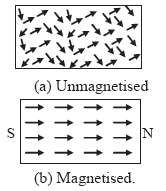
When such a piece is put in North–South direction and hammered, the atomic magnets align themselves in the direction of the earth’s field fig. They retain this alignment and the piece becomes a magnet with North (N) and (S) pole near ends. This magnet with two poles, is called a magnetic dipole.
Advantage : These have following two merits
(a) They may be given desired regular shape.
(b) They are strong.
(B) Electromagnet
Electromagnets are based on the magnetic effect of electric current. An electromagnet is usually prepared by placing a soft iron core in a solenoid, or by winding a large number of turns of an insulated wire (generally the insulated copper wire) on a cylindrical soft iron core. An electromagnet shows magnetic properties only as long as the electric current flows through the solenoid. Thus, electromagnets are temporary magnets.
Difference between electromagnet and permanent magnet
Electromagnet :
Nature of magnetism : Temporary. An electromagnet shows magnetism only as long as current flows through it.
Polarity : The polarity of an electromagnet can be changed by reversing the direction of the current.
Strength : The strength of an electromagnet can be increased or decreased by increasing or decreasing the current.
Permanent magnet (or Bar magnet) : Nature of magnetism : Permanent (or bar) magnets show permanent magnetism.
Polarity : Polarity of a permanent magnet cannot be changed.
Strength : The strength of a permanent magnet cannot be changed.
TWO POLES OF A MAGNET
Poles of a magnet : When ends of a magnet are dipped in iron filings, the filings stick to its ends only and not to its sides. It means that in magnets, centres of attraction are located near ends only. These centres of attraction near the ends of a magnet are called poles. When this magnet is freely suspended, the two ends point in north–south direction. The pole near the end pointing towards North (north–seeking end) is called North pole. The pole near the end pointing towards South (south–seeking end) is called South pole.
Interaction between poles : The magnetic poles exert forces on each other. Like pole repel each other, i.e., one north pole will repel another north pole or unlike poles attract each other i.e., north pole attract south pole.
MAGNETIC FIELD
Lines of Magnetic field (Magnetic lines of force)
Definition : A magnetic line of force, is a line straight or curved, in the magnetic field of a magnetic pole of magnetic dipole, such that the tangent at any point of this line gives the
direction of the magnetic field at that point.
Properties of Magnetic Lines of Force
These have following properties :
- They are always nearly normal to the surface of magnet at every point.

- They start from a north (positive) pole and end at a south (negative) pole.
- Two lines of force do not intersect each other.
- They tend to contract longitudinally (longitudinal contraction).
- They tend to expand laterally (lateral repulsion) so as to exert lateral pressure on neighboring lines.
- (The above two properties are similar to that of a stretched rubber band).
- The number of magnetic lines of force passing normally per unit area about a point,gives the intensity of the magnetic field at the point.
EARTH’S MAGNETIC FIELD
Earth Magnetism : Earth behaves as a huge magnet (or a giant solenoid). The source of this huge magnetism is given as the molten charged metallic fluid giving rise to a current flowing inside the core of the earth. This core has a radius of about 3500 km (earth’s radius is 6400 km).
Some Associated Terms
1. South Magnetic Pole (S) : It is near north geographical pole N.
2. North Magnetic Pole (N) : It is near south geographical pole S.

ORESTED’S EXPERIMENT
Arrangement : A straight wire AB is connected to a battery V and key K. The wire is held horizontally over a magnetic needle.
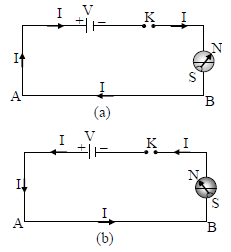
Working : When key is closed, current flows in the wire in the direction as shown. The needle deflects one side. When key is taken out and current in wire becomes zero, needle returns back to its initial position (S – N). This shows that a magnetic field is associated with an electric current.
When direction of current in wire is reversed,direction of deflection of needle is also reversed. If direction of current be kept same and wire be put under the needle, direction of deflection of needle again becomes reversed.
MAGNETIC FIELD DUE TO CURRENT CARRYING WIRE
(A) Straight wire :
It means that when the current flows in a straight wire, the magnetic field produced has circular lines of force surrounding the wire, having their centres at the wire as shown in fig. The plane of circular lines is perpendicular to the length of the wire. Their direction is marked by arrows.

fig, (b) Current circular, magnetic field straight
- It means that when the current flows in a circular wire (coil), the magnetic field produced has straight lines of force near the centre of the coil, as shown in figure. The parallel lines are in a plane perpendicular to the plane of the coil. Their direction is marked by the arrows.
- Rule : The direction of the magnetic lines of force is related with the direction of the current by the right hand thumb rule.
The rule states :
Curl the four fingers of the right hand on the palm, keeping the thumb stretched out at right angles. The thumb is straight and the fingers are circular.
*In case 1. thumb represents the direction of the current in the straight wire and curling of fingers represents the direction of the circular magnetic lines of force (fig.).

In case 2, curled fingers represents the direction of the current in circular wire and thumb represents the direction of the straight magnetic lines of force. (Fig.)

Right hand thumb rule for direction of magnetic field.
(C) Solenoid :
Definition : A solenoid is a straight cylindrical core on which a large number of turns of a insulated copper wire are wrapped.
It is shown in fig.

MAGNETIC FORCE
Force on a Current Carrying Wire due to
Magnetic Field :
Introduction : A current carrying conductor produces a magnetic field around it. When it is placed in a magnetic field, the two magnetic fields interact. A force acts on the conductor.
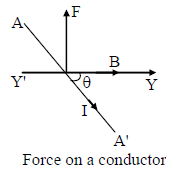
Expression : It is found by calculation that if the conductor of, length λ be carrying a current I lying inside a magnetic field of intensity B and making an angle θ with it, the force acting on it is given by
F = Iλ B sin θ
Fleming’s Left–Hand Rule :

Fleming’s left–hand rule is used to find out the direction of motion of a current–carrying conductor when placed in a magnetic field.This rule states as follows.
Stretch out the thumb, the forefinger, and the second (middle) finger of the left hand so that these are at right angles to each other. If the forefinger gives the direction of the magnetic field (N to S), the second (middle) finger the direction of current (+ to –), then the thumb gives the direction of the force acting on the conductor.
Since the conductor will move in the direction of the force acting on it hence the thumb gives the direction of motion of the conductor.
Force on a moving charge
- A current–carrying conductor (e.g., a wire) experiences a force when placed in a magnetic field. The current represents a collection of charged particles in motion. Therefore, each moving charged particle in a magnetic field will also experience a force, called Lorenz force.
- The direction of the force experienced by a positive charge is the same as that on the current and is given by Fleming’s left-hand rule.
- The force, experienced by a current carrying conductor in a magnetic field is given by,
F = B I λ - If Q is the charge passed through the conductor in time t, we can write
I =Q/t - The above relationships, when combined give,

EMI (ELECTROMAGNETIC INDUCTION)
Introduction : Whenever magnetic flux linked with a closed loop changes, an electric current is produced in the loop (a galvanometer connected with closed loop,shows a deflection). The current lasts only so long as the flux is changing.
This phenomenon is called electromagnetic induction. The electric current produced, is called induced current. The e.m.f. which produces this current, is called induced e.m.f.
ELECTRIC MOTOR (D.C. MOTOR)
(A) Principle : It works on the principle of motion of a current carrying conductor in a magnetic field, according to Fleming’s Left Hand Rule.
It is a device which converts electrical energy into mechanical energy of rotation.
(B) Diagram :

(C)Construction : It has four mains parts, named below.
- A field magnet having concave magnetic poles N–S, which provides a strong magnetic field.
- An armature, which is moving part of the motor. It has two parts :
(i) Laminated shaft X–Y.
(ii) Copper coil ABCD wrapped on end X of the shaft inside the field. - A pair of metallic split rings R1 and R2 (commutator).
- A pair of metallic carbon brushes B1 and B2.
(D)Working : A direct current (D.C.) source is connected between metallic brushes B1 and B2. When current passes through the coil, it flows in arms CB and AD in a direction perpendicular to the magnetic field. Equal and opposite forces act on these arms (in a direction according to Fleming’s Left hand Rule) and they form a couple. The coil rotates in clockwise direction (Fig.). After half rotation, split parts of ring change brushes. Current becomes reverse in the arms but couple acts in same direction as before. The coil continues rotating the shaft on which it is wrapped. Thus, rotatory motion (motor action) becomes available.
The rotation is not smooth with single coil. It is made smooth by increasing number of coils (multiphase motor) or preferably by having a continuous winding.
ALTERNATING CURRENT (AC)
The electric current which changes its direction (or polarity) after a certain fixed interval of time is called alternating current or AC. Thus, in AC, the polarity (+ or –) is not fixed. The electricity supplied to our homes and industry in our country is alternating current (AC).
Advantages of the alternating current (AC) :
The alternating current (AC) has the following advantages.
- The alternating current (AC) can be transmitted over long distances without much loss of energy and at low rate of transmission.
- The alternating current (AC) operated machines such as electric fan, electric motor etc., are more durable and convenient as compared to those operated on direct current (DC).
- Alternating current (AC) can be controlled by a choke coil at very low energy loss. On the other hand, direct current (DC) can be controlled only by ohmic resistances at relatively much higher energy loss.
GENERATOR
AC Generator
Construction of an ac generator : It consists of a rectangular coil of insulated copper wire. This coil is placed in a magnetic field between the poles of a strong permanent horseshoe magnet. This magnet is known as the field magnet. In actual practice, a large number of turns of the insulated copper wire are suitably wound on an iron core called armature.
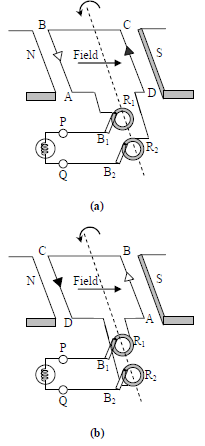
The two free ends of the coil are connected to the two slip rings R1 and R2. Current generated in the coil is taken out through the two carbon brushes B1 and B2 pressed lightly against the slip rings.
Working of an AC generator : Let the coil ABCD be initially in the horizontal position, and is rotated in the anticlockwise direction. When the coil is rotated anticlockwise, the arm AB moves downwards and the arm CD moves upwards. The coil during this movement cuts the magnetic lines of force, and produces induced current in the coil. According to the Fleming’s right–hand rule, during this downward motion of the arm AB, the induced current flows from B to A in the arm AB, and from D to C in the arm CD. The current so produced is taken out through the two slip rings, and the carbon brushes.
After half the rotation (after rotating through 180º), the arms of the coil interchange their position; the arm AB becomes the right arm and the arm CD becomes the left arm. Then, the arm CD starts moving downwards and the arm AB upwards. During this half–rotation, the induced current flows from C to D in the arm CD, and from A to B in the arm AB. The two slip rings also rotate with the coil. As a result, their polarities (+ and – poles) keep changing at every half–rotation.
The current which changes its polarity after regular intervals of time is called alternating current (AC). So, this electric generator produces alternating current (AC).
Frequency of the alternating current :
Alternating current (AC) so produced has a definite frequency. This frequency is equal to half the number of times the polarity changes in one second. In our country, the frequency of the alternating current supplied by the power generation units is 50 cycles per second (or Hz). This means, the alternating current (AC) produced in our country changes polarity 100times in one second.
DC generator
A DC generator stands for direct current electric generator. A DC generator produces direct current. A DC generator is also called DC dynamo. A simple DC generator is shown in fig.
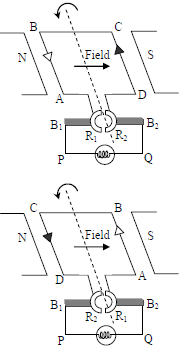
Construction of a DC generator : A simple DC generator consists of a coil of insulated copper wire. The coil is placed between the two poles of a strong horseshoe magnet. In actual practice, a large number of turns of the insulated copper wire are wound on a soft iron core.
The two ends of the coil are connected to the two halves of a split ring (R1, R2 called commutator). Two carbon brushes press against the two half–rings lightly. The current is taken out through the brushes B1 and B2.
Working of a DC generator : Let the coil ABCD be initially in the horizontal position, and be rotated anticlockwise. When the coil is rotated anticlockwise, the arm AB moves downwards and the arm CD moves upwards.
The coil during this motion cuts the magnetic lines of force and an induced current is produced in the coil. According to Fleming’s right hand rule, during the downward motion of the arm AB, the induced current flows from B to A in the arm AB, and from D to C in the arm CD. The current so produced is taken out through the two half–split rings, and the carbon brushes.
After half the rotation (rotation through 180º), the arms of the coil interchanged their positions; the arm AB comes to right and the arm CD to the left. Then the arm CD starts moving downwards, and the arm AB upwards. During this half–rotation, the induced current flows from C to D in the arm CD, and from A to B in the arm AB.The two half–split rings (R1 and R 2 ) rotate with the coil and touch the two carbon brushed (B1, B2) one by one. As a result, each carbon brush continues to have the same polarity, (+ or –). The brush B2 always remains positive (+) terminal, and the brush B1 remains negative (–) terminal. The current so produced is called direct current (DC).
DC generator differ from an AC generator: The basic design of AC and DC generators is similar. The two generators differ only in the design of slip rings at the ends of the coil wire. An AC generator use two full rings called slip rings, one at each end of the coil wire, while an DC generator has two half– rings (called split rings) of a commutator.
DOMESTIC ELECTRIC CIRCUITS
(A) Main board :
It is provided outside the building under a covered place (varandah or poarch). It contains the meter (energy–meter) and the main switch.
From the street electric pole a thick rubber insulated cord reaches the main board. It contains two thick copper or aluminium wires, one covered with red and the other covered with black (or brown) plastic covering.
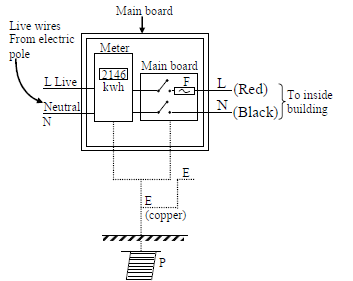
They from the live line wire (L) and neutral line wire (N) respectively. Live line has a potential of 220V whereas the neutral wire has zero potential (with respect to the earth). They enter the main board and are connected to the meter.
Wiring ahead is provided by the house owner himself. These wires are also red and black plastic covered. From the meter the wires enter the main switch. In the main switch, a fuse F is provided in the live wire. A third wire is a thick bare wire of copper, called earth wire E. It is connected to an earth connection which consists of a thick copper plate P buried deep inside the moist earth.
(B) Inside the building :
It is a well known fact that inside the house, connections to all the devices are made in parallel, each having independent switch and fuse (if necessary). Thus, whenever some fault occurs in circuit of one particular device in one room, devices in other rooms do not suffer.
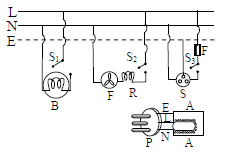
As shown in fig. connection to low power devices like bulb B and fan F are made with lines N and L only, putting switch in line L. For devices of more power and with whom the body remains in contact (like electric press or refrigerator), we use connections through a 3 pin plug–socket (show in fig. b) system.
A three pin plug P and three pin socket S are shown in diagram. The three points of the socket are connected to the three lines as shown in diagram. (fig. b) A fuse F is also introduced to avoid damage to the appliance. The three pin plug uses a three wire cord which has three plastic wires inside a single rubber insulating cover. The wire are coloured red, black and green to serve an extension of live, neutral and earth wires for the appliance. The three wires are connected to the three holes in the socket as shown in diagram. When the plug is inserted in the socket, proper lines become connected to the appliance.
(C) Function of earth wire :
Due to long use some covered wires inside the appliance may become bare and make contact with metallic body of the appliance. In such a case the appliance gives a shock if not earthed. The earth wire keeps the potential of the appliance zero and shock is avoided.
EARTHING , OVERLOADING & SHORT CIRCUITS
Earthing
Definition : Connecting the metallic body of a high powered electrical appliance (e.g. electric iron, refrigerator, oven, etc.) to the earth wire of domestic circuit, is called ‘earthing’.

In three pin plug, has three pins forming a triangle. The upper pin is thicker than the two lower pins. (fig.) The pins are connected inside the body of the plug to the three different coloured wires of a three–cored, wire cable [Fig.]. The colour code of the wires is green (Earth–E), Red (Live–L), Black or Brown (Neutral–N).
Benefits : Due to wear and tear with long use, the live wire inside the appliance becomes bare (uncovered) and touches the body of the applicance. This contact raises the potential of the body to the huge potential of the live wire. If we operate that appliance with bare foot, we will be getting a severe shock.
If the appliance is earthed, its body potential remains zero due to contact with the earth.Nothing is felt when such an appliance is operated.
We may conclude that we save ourselves from severe electric shocks, by earthing our electrical appliances.
Over–Loading and Short–Circuiting
The current exceeds the limit under two situations.
(i) over–loading (ii) short–circuiting
They are discussed ahead.
Over–Loading : When high powered electric appliances like refrigerator, airconditioner and electric iron are switched on simultaneously, total current through main wire may exceed the tolerance limit causing damage and fire. This situation causes over– loading.
Short–Circuiting : Due to long use wear and tear or defective insulating material, the live and the neutral wires may become bare at some points and come in direct contact. Due to zero resistance, a large current is produced and a huge sparking is caused at the point of contact. It may cause damages and fire. This situation is called short–circuiting.
Electric Fuse
Introduction : It is a small, simple and cheap but very useful electric appliance used in domestic electric circuits.
Working : Whenever there is sudden voltage rise in mains or “over–loading” or short– circuiting’ in domestic electric circuits, the current becomes very large and exceeds current tolerance of the electric appliance, the fuse becomes hot and melts to break the circuit. The appliance is saved from the damage to be caused by the large current.
POINTS TO BE REMEMBER
- A freely suspended magnet always stays north–south.
- The region around a magnet in which its magnetic force can be detected is called the magnetic field.
- Magnetic field is represented by magnetic field lines.
- The tangent at any point of a magnetic field line represents the direction of magnetic field at the point.
- The number of lines of force passing through a unit area represents the strength of the field.If the lines of force are closer, the magnetic field is stronger.
- The magnetic field lines around a current–carrying straight conductor are concentric circle around the conductor.
- The direction of magnetic field due to a current–carrying straight conductor is given by Fleming’s right–hand rule.
- The magnetic field due to a current–carrying solenoid is similar to that of a bar magnet.The magnetic field inside a solenoid is nearly uniform and is parallel to the axis of the solenoid.
- A magnet formed due to the magnetic field of a current is called an electromagnet. An electromagnet essentially consists of a soft iron core wrapped around with an insulated copper wire coil.
- An electric motor is a device that converts electrical energy into mechanical energy. It is based on the principle that : When a current carrying coil is placed in a magnetic field, a torque acts on it.
- When a conductor moves perpendicular to a magnetic field, an emf is induced across its ends. The direction of induced emf or the induced current is determined by the Fleming’s right–hand rule.
- Generator is based on the principle of electromagnetic field, with a continuous change in flux due to which an emf is induced.
- Power is transmitted from the power station to cities at high voltage and low current to minimize power loss.
- A fuse is a wire of high resistance and made up of a material of low melting point.


